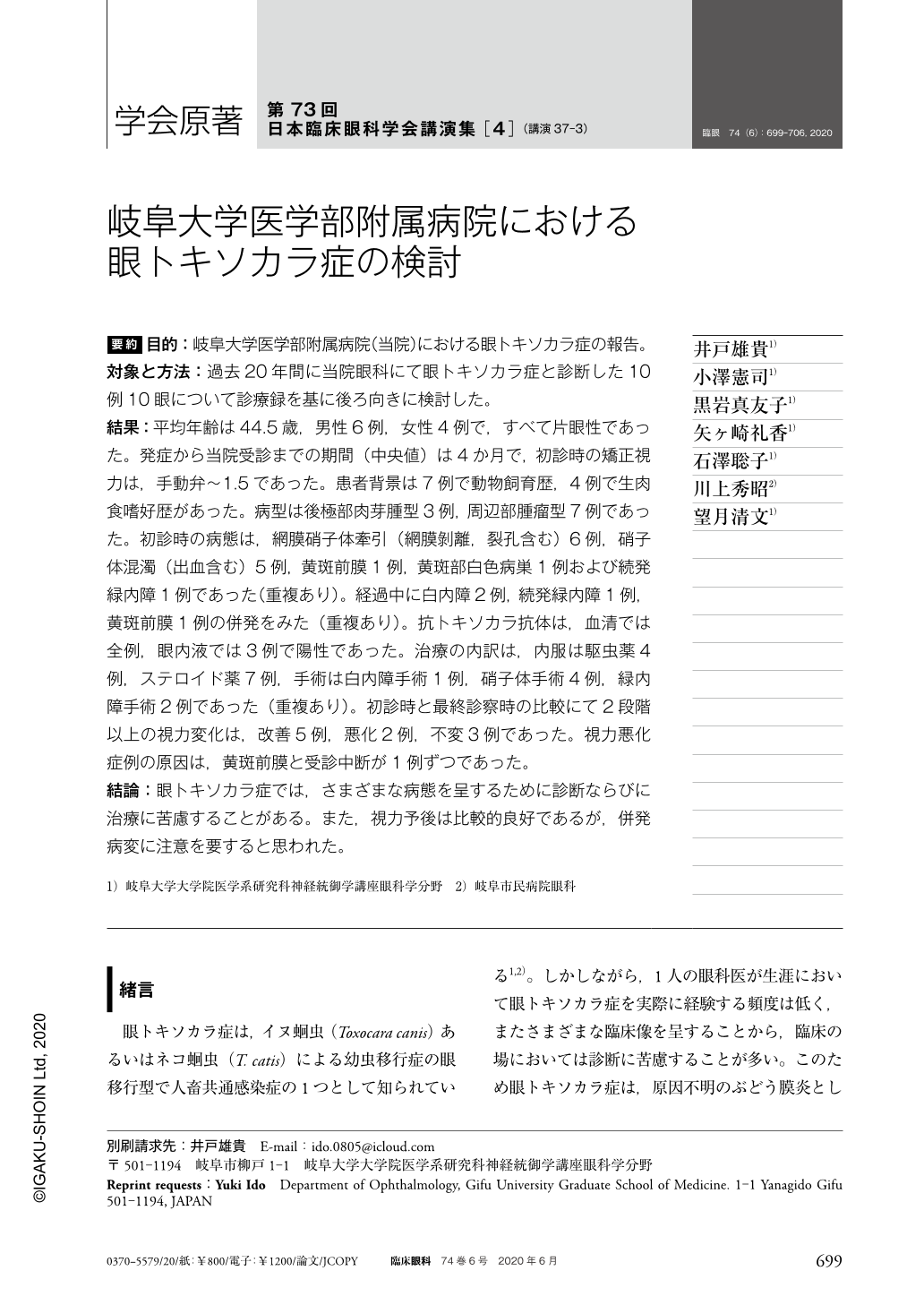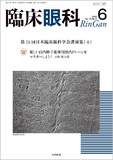Japanese
English
- 有料閲覧
- Abstract 文献概要
- 1ページ目 Look Inside
- 参考文献 Reference
要約 目的:岐阜大学医学部附属病院(当院)における眼トキソカラ症の報告。
対象と方法:過去20年間に当院眼科にて眼トキソカラ症と診断した10例10眼について診療録を基に後ろ向きに検討した。
結果:平均年齢は44.5歳,男性6例,女性4例で,すべて片眼性であった。発症から当院受診までの期間(中央値)は4か月で,初診時の矯正視力は,手動弁〜1.5であった。患者背景は7例で動物飼育歴,4例で生肉食嗜好歴があった。病型は後極部肉芽腫型3例,周辺部腫瘤型7例であった。初診時の病態は,網膜硝子体牽引(網膜剝離,裂孔含む)6例,硝子体混濁(出血含む)5例,黄斑前膜1例,黄斑部白色病巣1例および続発緑内障1例であった(重複あり)。経過中に白内障2例,続発緑内障1例,黄斑前膜1例の併発をみた(重複あり)。抗トキソカラ抗体は,血清では全例,眼内液では3例で陽性であった。治療の内訳は,内服は駆虫薬4例,ステロイド薬7例,手術は白内障手術1例,硝子体手術4例,緑内障手術2例であった(重複あり)。初診時と最終診察時の比較にて2段階以上の視力変化は,改善5例,悪化2例,不変3例であった。視力悪化症例の原因は,黄斑前膜と受診中断が1例ずつであった。
結論:眼トキソカラ症では,さまざまな病態を呈するために診断ならびに治療に苦慮することがある。また,視力予後は比較的良好であるが,併発病変に注意を要すると思われた。
Abstract Purpose:To report clinical findings and visual outcomes of ocular toxocariasis at Gifu University Hospital
Methods:We retrospectively analyzed 10 eyes of 10 patients with ocular toxocariasis who were treated at Gifu University Hospital between 1998 and 2018.
Results:Six patients were males and 4 were females. All of the cases were unilateral. Mean age at diagnosis was 44.5 years. The median duration between onset and diagnosis was 4 months. Best corrected visual acuity was between hand motion and 1.5. Seven cases had animal breeding history, and 4 cases preferred raw meat. 3 cases were central posterior granuloma type, and 7 cases were peripheral granuloma type. The main baseline findings were presence of retinal vitreous traction(6 cases), vitreous opacity(5 cases), epiretinal membrane(1 case), cotton-wool spot located at the macula(1 case), and secondary glaucoma(1 case). Secondary cataract was present in 2 cases, secondary glaucoma in 1 case, and epiretinal membrane in 1 case during the follow-up period. Anti-toxocariasis antibodies were seropositive in all cases by ELISA. Three cases showed intraocular IgG production against toxocariasis. Antihelminthic drugs were used in 4 cases, systemic corticosteroids in 7 cases. 4 cases needed vitrectomy, 1 case cataract surgery, and 2 cases glaucoma surgery. Compared with initial visual acuity, final visual acuity was better in 5 cases, worse in 2 case, unchanged in 3 cases. The reasons of worse visual acuity were epiretinal membrane and cessation of treatment respectively.
Conclusion:A variety of ocular findings hamper the accurate diagnosis and appropriate treatment in ocular toxocariasis. Although the visual outcome is fair, we should pay close attention to complications.

Copyright © 2020, Igaku-Shoin Ltd. All rights reserved.


